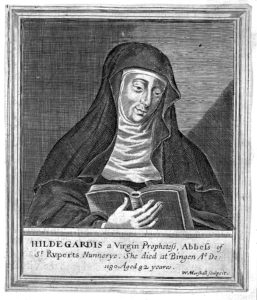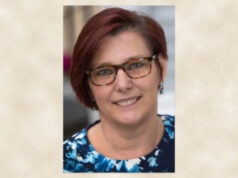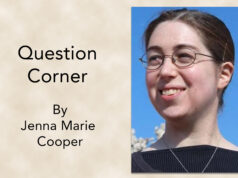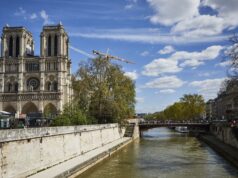Although she lived in medieval times, St. Hildegarde of Bingen could definitely been seen as a “Renaissance woman.” Mystic, herbalist, scientist, composer, brewer, theologian — she was gifted with great knowledge, intellect, spirituality and creative talent.
Born in 1098 to a noble German family, Hildegard began seeing visions that she referred to as the “The Living Light” at age three. She entered a Benedictine monastery sometime between age 8-14 and studied under a fellow mystic named Jutta. Jutta took Hildegard under her wing, teaching her to read and write and learn the Scriptures.

By William Marshall. (Wikimedia Commons, available under Creative Commons Attribution only license CC BY 4.0)
While growing up in the monastery, Hildegard studied and mastered herbalism, science, nature, theology and music. She took formal vows as a religious at 18, and shortly after wrote about her lifetime of visions. When Pope Eugene III read her book, he encouraged her to write more. Although she did not have what was considered a traditional education, Hildegarde became a spiritual adviser to many. Hundreds of her writings on theology and her vast correspondence to fellow saints, popes, emperors and fellow religious have survived. Her writing on nature and scientific topics is considered groundbreaking. She composed more than 70 musical works, one of the largest collections for composers of her time. Her most famous composition is Ordo Virtutum. She was also said to have invented an alternative alphabet or code.
Interestingly, Hildegard discovered that the hops used in brewing beer kept the brew from spoiling. Because of this revelation, she is also considered to be the patron saint of hop growers.
After Jutta’s death, Hildegard was elected Abbess by her fellow sisters. They later moved the monastery to Bingen.
Hildegard died in 1179 and the sisters reported seeing rays of light in the room where she died and across the skies above the monastery. Her relics can be found at a parish church in Eibingen in Germany.
St. Hildegard was one of the first saints to be nominated for the formal beatification process; her cause was submitted before the 16th century. Because the process was new, her case for sainthood was tangled up in ecclesiastical red tape for hundreds of years. Pope Benedict XVI finally rectified the problem by declaring her a saint on May 10, 2012 in a process known as “equivalent canonization.” He later named her a Doctor of the Church, the fourth woman to hold that honor, calling her “an authentic teacher of theology and a profound scholar of natural science and music.”
St. Hildegard of Bingen’s Feast Day is Sept. 17.
She is the patron saint of musicians, writers and brewers.
Read her biography at Franciscan Media here:
German film director Margarethe von Trotta made a movie about St. Hildegard’s life. Learn more here.
St. Hildegarde is mentioned in this story about patron saints of beer.
Check out this YouTube video featuring a beautiful performance of one of St. Hildegard’s musical compositions here.









